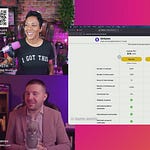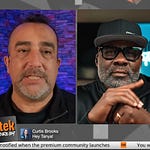Let’s dive into a fun and experimental deep dive into live streaming tech, specifically the exciting new beta feature from RODE called “Call Me” on the RODECaster Pro 2. This episode is all about testing, breaking things (intentionally!), and exploring how this tool can revolutionize live shows and video podcasts by enabling live call-ins.
Thank you
, , , , , and many others for tuning into my live video! Join me for my next live video in the app.So, if you’ve ever wanted to run a call-in show with real-time audience interaction — just like the old radio days but with modern tech — this episode is your guide. And if you’re thinking about podcasting or live streaming with more engagement, stick around because there’s a lot to unpack and some strategic advice for you.
Episode Breakdown & Key Topics
Introduction to the RODECaster Pro 2 and the “Call Me” Beta Feature (00:11 - 08:40)
How to Use the Call Me Feature: Setup and Live Testing (08:42 - 16:00)
Live Call-In Conversations: Pros, Cons, and Real-World Use Cases (16:01 - 38:50)
Technical Tips and Best Practices for a Smooth Live Call-In Show (38:51 - 52:00)
Q&A: Livestream vs. Prerecorded Podcast, Streaming Platforms, and Software Recommendations (52:01 - 1:04:01)
Wrap-Up: Final Thoughts and Next Steps for Streamers & Podcasters (1:04:02 - End)
Introduction to the RODECaster Pro 2 and the “Call Me” Beta Feature
Let’s start with the basics: the RODECaster Pro 2 isn’t just your average soundboard; it’s a powerhouse designed for podcasters and live streamers who want professional audio quality and seamless control. RODE, a company known for its microphones, has expanded into soundboards with models like the Duo, the original RODECaster Pro, and now the Pro 2, which features a sleek interface full of buttons and lights.
What caught my eye—and what I was eager to test—is their new beta firmware feature called “CallMe.” This feature allows you to open a phone line directly through your RODECaster, enabling live call-ins during a stream or recording session. Imagine taking live audience questions or interviews without complicated setups or third-party apps.
The best part? It’s accessible via a simple QR code, and callers don’t even need to be on video or have fancy equipment—they just scan (or visit the link), enter a code, and they’re live on your show with audio.
How to Use the CallMe Feature: Setup and Live Testing
So how does this work in practice? Here’s a quick rundown:
Beta Firmware Installation: To enable “Call Me,” you first need to update your RODECaster Pro 2 to the beta firmware. This involves tapping a specific area on your device multiple times to unlock beta mode and then installing the firmware update.
Assigning the Call Me App: Once installed, you assign the Call Me app to one of your device’s physical buttons (I used the last fader on my Pro 2).
Generating the QR Code: When you press that button during your show, a unique QR code appears that you can share with your audience.
Audience Call-In: Your viewers scan the QR code with their phone, visit callme.rode.com, and enter the code displayed on your screen to join the call.
Managing Calls: On your end, you can accept or reject calls, assign callers to lines, and manage the conversation—all from the RODECaster interface.
During my live test, I invited friends and community members to call in. It was a little bumpy at first but with a few technical tweaks like using headphones to avoid feedback, it quickly became a smooth experience.
This hands-on testing revealed some fun and practical insights, like:
It’s easy to take one call at a time.
Calls time out if no answer, so callers have to dial back in if you don’t accept.
You can share a new code after each session to avoid unwanted calls.
Live Call-In Conversations: Pros, Cons, and Real-World Use Cases
We had some great conversations during the live call-in segment, including a thoughtful discussion on the age-old question:
“What’s better: a live stream podcast or a prerecorded podcast?”
Here’s the gist of my take:
Live Streams: They offer authenticity, real-time engagement, and a genuine human connection. Viewers get to see the imperfect, authentic you—dogs barking, doorbells ringing, and all. This level of transparency is something many audiences crave today.
Prerecorded Podcasts: These shine in polished production quality, tighter editing, and the ability to appeal to sponsors who want a sleek final product.
My guest, Junaid Ahmed, a studio designer and podcaster, agreed that live streaming gives you that “one and done” authentic connection, but he also pointed out the practicality of prerecorded episodes when you’re producing multiple shows a week.
With caller 2, Robert Kennedy III (RK3), we also explored how this call-in feature can be used for:
Audience Q&A sessions
Live interviews with guests who may not want to be on camera
Interactive coaching calls or on-the-spot coaching during broadcasts
One caller - Coach Shawn Michaels - joined from Guatemala, which proved that this feature isn’t geographically limited—opening up global possibilities for your show.
Technical Tips and Best Practices for a Smooth Live Call-In Show
Now, if you’re thinking about running your own call-in show with this tool, here are some important technical and strategic tips I learned:
1. Strong Internet Connection is a Must
Hardwire your RODECaster Pro 2 to your router with an ethernet cable. WiFi might work, but for live calls, a solid wired connection is essential to avoid drops and lag.
2. Manage Your Audience Carefully
Since you’re streaming to multiple platforms simultaneously (I streamed on Substack, YouTube, Facebook, LinkedIn, Instagram, and more!), you won’t always know every viewer. Keep an eye out for regular attendees and be ready to block or remove any disruptive callers immediately.
3. Use the Name Recognition Feature
Callers enter their name when dialing in. Use this to screen who you accept on air. If you don’t recognize the name, feel free to skip the call to keep the show positive.
4. Rotate Your Call-In Code
After each show, turn off hosting on the Call Me app to generate a new code. This prevents random or unwanted calls outside your live session.
5. Prepare for Echo Issues
Echo can happen if callers aren’t using headphones or have their speakers too loud. Encourage callers to use headphones or mute their speakers to minimize feedback.
6. Limit One Call at a Time
Currently, the system only supports one call-in at a time. Plan your show flow accordingly, and if you want multiple guests, have them join sequentially.
Are there subscription fees for Call Me?
Yes, the Call Me app has a free tier with limited hours and paid plans for more usage. For someone like me who streams once a week, the free or lower-tier plans should suffice.
Final Thoughts and Next Steps for Streamers & Podcasters
This experimental live AMA and call-in session was a blast and a valuable learning experience. The RODECaster Pro 2’s Call Me beta opens up exciting possibilities for podcasters and live streamers seeking authentic, real-time audience interaction without complicated phone setups.
Here’s what I recommend if you want to try it out:
Get your RODECaster Pro 2 updated to the beta firmware and assign the Call Me app.
Prepare your streaming setup with a wired internet connection and headphones for callers.
Set clear ground rules for callers to keep your show positive and professional.
Use this feature to add authenticity and engagement to your live shows or video podcasts.
Experiment with multi-platform streaming to maximize your reach.
As I continue to remix my own video podcast, “Stream Like a Boss TV The Remix,” this tool will be an essential part of making the show more interactive and fun. I can’t wait to see how this evolves and how you all start leveraging it in your own creative ways.
Remember, the key to mastering any streaming or podcasting tool is to get in there, break things, learn, and then teach others what you discover. That’s the journey we’re all on together.
Join the Community!
If you found these insights helpful, don’t forget to subscribe to the podcast and join the conversation. Leave a review, share your own live streaming or podcasting stories, and let’s keep pushing the boundaries of what’s possible with video, audio, and live interaction.
Want to learn more about live streaming and video podcasting? Visit streamlikeaboss.tv to check out upcoming workshops, boot camps, and resources designed to help you grow your audience and scale your business with video.
Stay curious, keep experimenting, and I’ll see you in the next stream.










